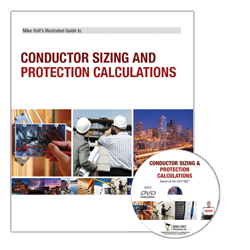Fault Current Impact on Conductor Sizing (7-21-99)
Download this article [ Word™ ] [ PDF ]
Could you please explain the impact of fault currents on conductor insulation, terminals and the conductors itself? Could you give examples that we can all relate to?
Response No. 1
Every piece of electrical apparatus has a short-circuit withstand rating. It can carry only so much current for so much time before it is damaged. For example, bus duct may have a short-circuit rating of 50,000 amperes for three cycles. If 75,000 amperes were to flow through the bus for three cycles, it might be damaged. Or. If 50,000 amperes flow for 12 cycles, it might also be damaged. Nationally Recognized Testing Labs such as UL often take short-circuit withstand ratings into account when they test products. In our example above, the short circuit test on the busway would likely include the overcurrent device. So, the busway might be tested at 100,000 amperes when protected by an 800 ampere Class L fuse. If the busway passed the test, it would be marked as suitable for use on a circuit capable of delivering 100,000 amperes when protected by a Class L fuse of no greater than 800 amperes.
When we look at conductor protection, there are three levels that need to be considered. The first level is protection for the insulation. ICEA (Insulated Cable Engineers Association) has published charts showing how much current for how much time it takes to begin damaging insulation. For example, if a copper conductor with 75-degree C insulation reaches 150 degrees C., the insulation will begin to be damaged. The second level is the "validity" or annealing level. It is for the point where the metal conductor begins to anneal, and therefor, after cooling down, it no longer is tight under the terminals or lugs. For example, copper begins to anneal at about 250 degrees C. If the conductor should carry enough current for a long enough time to reach 250 degrees C, when it cooled down, it would not be tight under the lugs. This second rating is especially important for the protection of equipment grounding conductors. This was the basis for some of the Eustice Soares work. The third level of protection is the point where the conductor vaporizes. For copper this occurs at 1083 degrees C. It is obvious that we never want to reach that level.
The formula that is used for a basis for all three levels of protection is a "simple" physics formula that determines how much current it takes to raise a certain cross section of copper from one temperature to another. There is nothing magical about the formula, and is something that might be derived in a college physics class from other commonly accepted formulas.
That formula is [I/A]squared(t)=.0297 log [(T2 + 234)/ (T1 + 234)]
Where I = Short Circuit Current in Amperes
A = Conductor cross sectional area in circular mills (See Table 8 of the 1999 NEC, page 70-567)
t = time of short circuit in seconds
T1 = Maximum Operating Temperature in degrees C. (For thermoplastic insulation this might be 75 degrees C)
T2 = Maximum Short Circuit Temperature in degrees C. (For thermoplastic insulation this would be 150 degrees C., for the validity rating or annealing rating this would be 250 degrees C., and for vaporization, this would be 1083 degrees C.)
Using the above formula and checking for insulation protection, a # 6, 75 degree C. copper conductor can withstand 21,500 amperes for 1/4 cycle, 16,200 amperes for 1/2 cycle, 10,800 amperes for 1 cycle, 7,600 amperes for 2 cycles, and 6,200 amperes for 3 cycles. For more information go to https://www.bussmann.com/Library/Library.html and see bulletin SPD.
Question No. 2
Also how to comply with the following NEC Code Sections.
Response No. 1
Section 110-10. States that "the total impedance, the component short-circuit current ratings, and other characteristics of the circuit to be protected shall be selected and coordinated to permit the circuit-protective devices used to clear a fault to do so without extensive damage to the electrical components of the circuit." This Section requires that all equipment be applied within its "withstand" or short-circuit ratings. So, for the example above, if a #6 conductor were subjected to more than 16,200 amperes for 1/2 cycle, the insulation would have begun to be damaged, and it would be a violation of Section 110-10.
One should also be aware of the new last sentence (1999 NEC) of Section 110-10, which says, "Listed products applied in accordance with their listing shall be considered to meet the requirements of this section."
This new last sentence makes it extremely important for the user to read, understand and apply products according to the product standards. For example, the bus in a switchboard has a three-cycle rating (UL 891). It would be a violation to protect that switchboard with a power circuit breaker that had a short-time delay set at 12 cycles. One would have to know the standard to know that it is tested for only three cycles before knowing that you couldn't apply a 12-cycle device on it. This and similar requirements are quite often overlooked.
The note to Table 250-122 states that "Where necessary to comply with Section 250-2(d), the equipment grounding conductor shall be sized larger than this table.
Section 250-2(d) states "The fault current path shall be permanent and electrically continuous, shall be capable of safely carrying the maximum fault likely to be imposed on it, and shall have sufficiently low impedance to facilitate the operation of overcurrent devices under fault conditions." This is an area that is often overlooked, and is especially hard to meet because the size of the equipment grounding conductor is often several sizes smaller than the size of the overcurrent protective device. For example, a 60 ampere circuit, protected by a 60 ampere overcurrent device, could have a #10 copper equipment grounding conductor. Now, if the phase conductor should be shorted to ground, that ground return path would be through the #10 equipment grounding conductor. So, the 60 ampere device is being asked to protect the #10 conductor. Looking at the possible levels of protection as described above, either the conductor insulation level or the "validity" level could be appropriate. If the equipment grounding conductor were insulated, we wouldn't really care too much if the insulation were damaged a little bit. But we certainly wouldn't want any other conductors in the raceway to become damaged and we definitely would not want the conductor to become loose under the lug because we then have a real safety issue. So, it is difficult call of whether to use the 150-degree C. level or the 250-degree C. level. If it was a bare equipment grounding conductor, and it was run in conjunction with other insulated conductors, we would not want to damage any of the other insulated conductors and would therefor tend to protect at the 150 degree C. level.
Are there any resources such as web sites, spread sheets, booklets, etc?
Yes, see the Bussmann site at www.bussmann.com and Bussmann bulletins SPD 99 (See section on Component Protection), and NE 99 (See Section 110-10).
Vince Saporita, Bussman Fuses
Response No. 2
The best source to use for Fault Current effects is the SPD from Busssmann. They have excellent presentations of Fault Current effects and Short Circuit with stand ratings. If you contact your local Bussmann Engineer they will be able to help you. Their Electrical Code knowledge is excellent.
Fred W. Brown
Response No. 3
Two sources of good information on this are the yellow Bussman SPD Handbook, and Soares Grounding, published by the IAEI. A significant change in the 1999 NEC Article 250 is the Note to 250-122 which now states "where necessary to comply with Section 250-2(d) the equipment grounding conductor shall be sized larger than this table". The previous wording was may.
The intent is to evaluate the amount of fault current the equipment grounding conductor can carry before the OCPD trips. Mike suggests that the equipment grounding conductor be sized so that it will carry at least 5 times (ten is better) the rated current of the OCPD.
The Steel Tube Institute has a free computer program called GEMI that evaluates the equipment grounding conductor for various sizes and lengths. For more information on this program contact Dick Lyod.
Tom Baker
| Get Up to Speed Quickly with the Latest Information | |

|
This book was extracted from the full textbook titled, Electrical Exam Preparation. This program explains conductor ampacity calculations when corrected for ambient temperature and conductor bunching, and the effects of terminal rating on conductor sizing. Covers "next size up" rule, tap rules, and much more! Includes Articles 240 and 310. Inlcudes one 4-hour DVD and textbook. More Information |






 Products
Products Cart
Cart